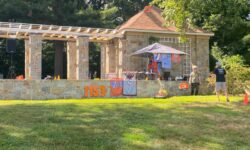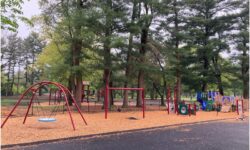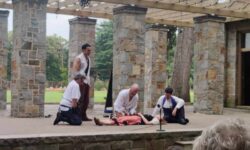By Amelia Tarallo
Hometown Weekly Staff
Bird Park has always been a popular spot during the summer. With wide-open fields, playgrounds, and a number of trails, the park has something for everyone to enjoy. On Saturday, August 9, I visited to try the self-guided Women’s Suffrage and the Bird Family walk. It combines three of my current favorite things: effortless exercise, quiet, and a history lesson.
This newly decorated trail celebrates the 19th Amendment and the women who fought for its passing. August 18 will mark 100 years since the amendment was ratified, giving women the right to vote. Almost everyone in Walpole knows about the 19th Amendment, but the significant role the Bird family played to get it passed tends to be unknown to most.
The park is noisy today, with kids on bikes, parents watching their kids at the playground, and dog owners throwing toys to their furry friends. The last time I visited in December was almost completely silent, with snow crunching under my feet. It’s definitely a change.
I begin my walk at the stone stage (the Music Court). Most of the time when I come to Bird Park, there’s some sort of event going on the stage. A concert, a play, and even on one occasion, a show about owls. But today, there’s a couple of kids running around on the stage as their mother looks on. To the left is a trail that I have never noticed until now. All of my prior visits at Bird Park have been focused on the stage, or strolling around the green fields. This time, I’m venturing into an area I never knew existed. I spot the yellow sign advertising the self-guided tour and I know that I’m in the right place.
A few steps in and I’m greeted by the first of a dozen signs on posts about the 19th Amendment. Like the day back in December, it is almost completely silent except for the leaves underneath my feet. The first few signs introduce the 19th Amendment with the text itself, and the suffragette movement. The next signs introduce individuals important to the movement. One post notes two of the most famous women’s right activists: Lucy Stone and Susan B. Anthony. I feel a weird connection to these two. Anthony’s birthplace is located just miles from where I lived for a year in the Berkshires, while Stone briefly attended my alma mater, Mount Holyoke, when it was still a seminary run by its founder. While I understand the connection to Massachusetts, I’m not quite sold on the connection to Bird Park.
I realize just moments later that an introduction to these two was to get visitors to recall suffragettes they probably already know, before introducing them to some new players. Just a few steps away is a sign about Julia Ward Howe. As an activist, Howe worked closely with Lucy Stone, leading the American Suffrage Association. Additionally, she was an accomplished writer. She wrote the lyrics to "The Battle Hymn of the Republic," as well as a biography of Francis William Bird, the grandfather of the park’s namesake. At this moment, it’s clear that Bird Park has a more impressive connection to the 19th Amendment than I realized.
I continue my walk and read the next sign that explains Howe’s relationship with the Bird family. Frank Bird was an avid women’s rights supporter, hosting suffragettes at the Bird Club. At the time, the club was a political center of Massachusetts. Bird’s daughter-in-law, Anna Julia Child Bird (married to Charles Sumner Bird, and mother of the park’s namesake), led the 1918 and 1920 Massachusetts Woman’s Suffrage Association conventions. The work of Anna Julia Child Bird included her role with the Women’s City Club of Boston and the Women’s Trade Union. She was politically active, supporting women, her husband, and catching the eyes of prominent politicians, including Teddy Roosevelt.
I continue my walk. All I know about Anna Julia Child Bird is based on the last few signs, and I’m eager to know more. I discover from the next sign that Bird was on the Board of Women Voters and that she served as a Republican Party leader (she was the first women elected delegate to the Republican National Convention, and one of the first female delegates of the Electoral College).
Her work in Walpole was also crucial to the improvement of women’s life. She founded the local women’s club in 1920, which “promoted a dental clinic, a nurse’s Association, health and safety campaigns, and a town planning board.” According to the sign, the club was likely behind the production of the “Health Play” put on at the park in the 1920s. There is a picture of a crowd of people in front of a stage that looks very similar to the one where I started this walk. I envy them in a way; they got to see a play about health concerns without worrying about social distancing.
The rest of the signs discuss the creation of Bird Park and a few of Bird's other local endeavors. By the end of the walk, I find myself turning around, going back on to the trail to reread some of the signs. By the end of the loop, I find myself questioning two things: how have I not heard about Anna Julia Child Bird before this, and has anyone written a biography about her? I’ll go home and do some more research, but I can definitely say that this trek was worth the visit to Bird Park.























